Case Based Questions Test: System of Particles & Rotational Motion - NEET MCQ
10 Questions MCQ Test Topic-wise MCQ Tests for NEET - Case Based Questions Test: System of Particles & Rotational Motion
Position of centre of mass
In a uniform gravitational field the centre of mass coincide with the centre of gravity. But these two points do not always coincide, however. For example, the Moon’s centre of mass is very close to its geometric centre (it is not exact because the Moon is not a perfect uniform sphere), but its centre of gravity is slightly displaced towards Earth because of the stronger gravitational force on the Moon’s near side facing the earth. If an object does not have a uniform weight distribution then the center of mass will be closer to where most of the weight is located. For example, the center of gravity for a hammer is located close to where the head connects to the handle. The center of mass can be located at an empty point in space, such as the center of a hollow ball. The center of gravity can even be completely outside of an object, such as for a donut or a curved banana.
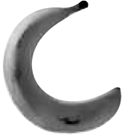
Standing upright, an adult human’s centre of mass is located roughly at the center of their torso. The centre of mass rises a few inches when with rising arms.
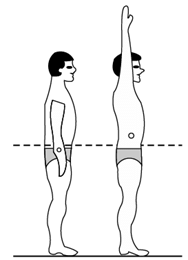
The center of gravity can even be at a point outside the body, such as when bent over in an inverted-U pose.
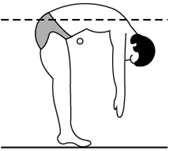
An object is in balanced position if its center of gravity is above its base of support. For the two cylinders below, the left cylinder’s CG is above the base of support so the upward support force from the base is aligned with the downward force of gravity. For the cylinder on the right the CG is not above the base of support so these two forces cannot align and instead create a torque that rotates the object, tipping it over.
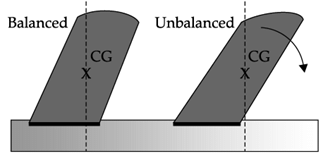
Does the centre of mass does not coincide with the centre of gravity of a body?




Position of centre of mass
In a uniform gravitational field the centre of mass coincide with the centre of gravity. But these two points do not always coincide, however. For example, the Moon’s centre of mass is very close to its geometric centre (it is not exact because the Moon is not a perfect uniform sphere), but its centre of gravity is slightly displaced towards Earth because of the stronger gravitational force on the Moon’s near side facing the earth. If an object does not have a uniform weight distribution then the center of mass will be closer to where most of the weight is located. For example, the center of gravity for a hammer is located close to where the head connects to the handle. The center of mass can be located at an empty point in space, such as the center of a hollow ball. The center of gravity can even be completely outside of an object, such as for a donut or a curved banana.
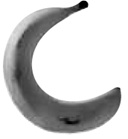
Standing upright, an adult human’s centre of mass is located roughly at the center of their torso. The centre of mass rises a few inches when with rising arms.

The center of gravity can even be at a point outside the body, such as when bent over in an inverted-U pose.
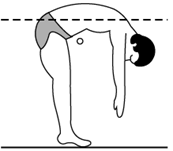
An object is in balanced position if its center of gravity is above its base of support. For the two cylinders below, the left cylinder’s CG is above the base of support so the upward support force from the base is aligned with the downward force of gravity. For the cylinder on the right the CG is not above the base of support so these two forces cannot align and instead create a torque that rotates the object, tipping it over.
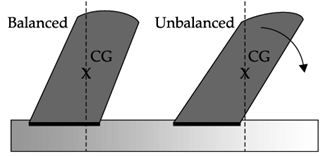
Identical blocks are connected as shown. Where the center of mass is expected to be located?
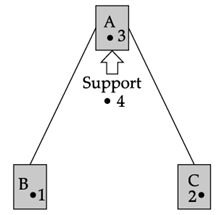





Position of centre of mass
In a uniform gravitational field the centre of mass coincide with the centre of gravity. But these two points do not always coincide, however. For example, the Moon’s centre of mass is very close to its geometric centre (it is not exact because the Moon is not a perfect uniform sphere), but its centre of gravity is slightly displaced towards Earth because of the stronger gravitational force on the Moon’s near side facing the earth. If an object does not have a uniform weight distribution then the center of mass will be closer to where most of the weight is located. For example, the center of gravity for a hammer is located close to where the head connects to the handle. The center of mass can be located at an empty point in space, such as the center of a hollow ball. The center of gravity can even be completely outside of an object, such as for a donut or a curved banana.
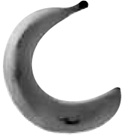
Standing upright, an adult human’s centre of mass is located roughly at the center of their torso. The centre of mass rises a few inches when with rising arms.
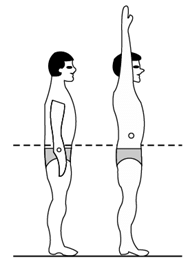
The center of gravity can even be at a point outside the body, such as when bent over in an inverted-U pose.

An object is in balanced position if its center of gravity is above its base of support. For the two cylinders below, the left cylinder’s CG is above the base of support so the upward support force from the base is aligned with the downward force of gravity. For the cylinder on the right the CG is not above the base of support so these two forces cannot align and instead create a torque that rotates the object, tipping it over.
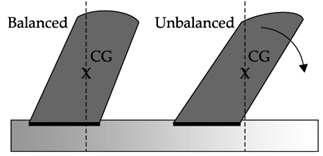
Centre of gravity of Moon is slightly displaced towards Earth because




Position of centre of mass
In a uniform gravitational field the centre of mass coincide with the centre of gravity. But these two points do not always coincide, however. For example, the Moon’s centre of mass is very close to its geometric centre (it is not exact because the Moon is not a perfect uniform sphere), but its centre of gravity is slightly displaced towards Earth because of the stronger gravitational force on the Moon’s near side facing the earth. If an object does not have a uniform weight distribution then the center of mass will be closer to where most of the weight is located. For example, the center of gravity for a hammer is located close to where the head connects to the handle. The center of mass can be located at an empty point in space, such as the center of a hollow ball. The center of gravity can even be completely outside of an object, such as for a donut or a curved banana.
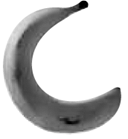
Standing upright, an adult human’s centre of mass is located roughly at the center of their torso. The centre of mass rises a few inches when with rising arms.

The center of gravity can even be at a point outside the body, such as when bent over in an inverted-U pose.

An object is in balanced position if its center of gravity is above its base of support. For the two cylinders below, the left cylinder’s CG is above the base of support so the upward support force from the base is aligned with the downward force of gravity. For the cylinder on the right the CG is not above the base of support so these two forces cannot align and instead create a torque that rotates the object, tipping it over.
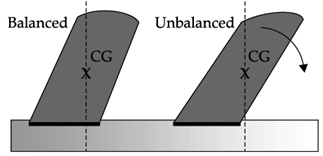
Two similar blocks are shown below. The first block is top-heavy and the second block is bottom heavy. Where the centers of mass will be located?
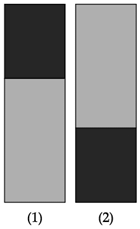
Position of centre of mass
In a uniform gravitational field the centre of mass coincide with the centre of gravity. But these two points do not always coincide, however. For example, the Moon’s centre of mass is very close to its geometric centre (it is not exact because the Moon is not a perfect uniform sphere), but its centre of gravity is slightly displaced towards Earth because of the stronger gravitational force on the Moon’s near side facing the earth. If an object does not have a uniform weight distribution then the center of mass will be closer to where most of the weight is located. For example, the center of gravity for a hammer is located close to where the head connects to the handle. The center of mass can be located at an empty point in space, such as the center of a hollow ball. The center of gravity can even be completely outside of an object, such as for a donut or a curved banana.
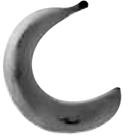
Standing upright, an adult human’s centre of mass is located roughly at the center of their torso. The centre of mass rises a few inches when with rising arms.
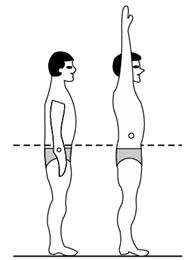
The center of gravity can even be at a point outside the body, such as when bent over in an inverted-U pose.
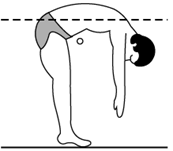
An object is in balanced position if its center of gravity is above its base of support. For the two cylinders below, the left cylinder’s CG is above the base of support so the upward support force from the base is aligned with the downward force of gravity. For the cylinder on the right the CG is not above the base of support so these two forces cannot align and instead create a torque that rotates the object, tipping it over.
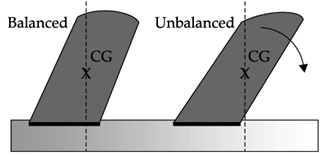
The leaning tower of Pisa does not fall since
Flywheel and sewing machine
There is a difference between inertia and moment of inertia of a body. Inertia depends on the mass of the body but the moment of inertia about an axis depends on the mass of the body and the distribution of its mass about the axis. In the following figure, the masses of the two wheels are exactly equal but in the wheel (A) the mass is uniformly distributed and in the wheel (B) most of the mass is situated at the rim. Both the wheels rotate about axis passing through the centre. It is noticed that while the two wheel are set in rotation and left, wheel (B) continues rotating for a longer time.
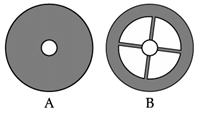
This means that the moment of inertia of wheel (B) is greater than the wheel (B). Also greater is the part of the mass of the body away from the axis of rotation, greater the moment of inertia of the body about the axis. Such a wheel is known as flywheel. Consider a foot operated sewing machine. It has of two wheels – one big and the other small. The wheels are connected by a rope. The bigger wheel acts as flywheel. The rope transfers the motion from this flywheel to the smaller wheel. Smaller wheel works as a pulley and also as a small flywheel.
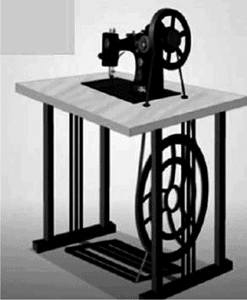
We see even we stop supply of driving force to the bigger wheel it still continues to run for a short time because of its moment of inertia. So, flywheel acts as an energy reservoir by storing and supplying mechanical energy when required. The kinetic energy stored in a flywheel is
![]()
(where I = moment of inertia and ω = angular velocity).
Which of the following statement is true?
Flywheel and sewing machine
There is a difference between inertia and moment of inertia of a body. Inertia depends on the mass of the body but the moment of inertia about an axis depends on the mass of the body and the distribution of its mass about the axis. In the following figure, the masses of the two wheels are exactly equal but in the wheel (A) the mass is uniformly distributed and in the wheel (B) most of the mass is situated at the rim. Both the wheels rotate about axis passing through the centre. It is noticed that while the two wheel are set in rotation and left, wheel (B) continues rotating for a longer time.
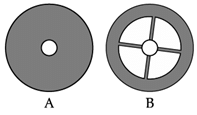
This means that the moment of inertia of wheel (B) is greater than the wheel (B). Also greater is the part of the mass of the body away from the axis of rotation, greater the moment of inertia of the body about the axis. Such a wheel is known as flywheel. Consider a foot operated sewing machine. It has of two wheels – one big and the other small. The wheels are connected by a rope. The bigger wheel acts as flywheel. The rope transfers the motion from this flywheel to the smaller wheel. Smaller wheel works as a pulley and also as a small flywheel.
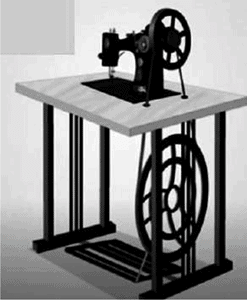
We see even we stop supply of driving force to the bigger wheel it still continues to run for a short time because of its moment of inertia. So, flywheel acts as an energy reservoir by storing and supplying mechanical energy when required. The kinetic energy stored in a flywheel is
![]()
(where I = moment of inertia and ω = angular velocity).
How many flywheels are there in foot operated sewing machine ?
Flywheel and sewing machine
There is a difference between inertia and moment of inertia of a body. Inertia depends on the mass of the body but the moment of inertia about an axis depends on the mass of the body and the distribution of its mass about the axis. In the following figure, the masses of the two wheels are exactly equal but in the wheel (A) the mass is uniformly distributed and in the wheel (B) most of the mass is situated at the rim. Both the wheels rotate about axis passing through the centre. It is noticed that while the two wheel are set in rotation and left, wheel (B) continues rotating for a longer time.
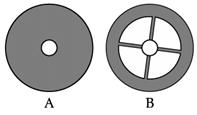
This means that the moment of inertia of wheel (B) is greater than the wheel (B). Also greater is the part of the mass of the body away from the axis of rotation, greater the moment of inertia of the body about the axis. Such a wheel is known as flywheel. Consider a foot operated sewing machine. It has of two wheels – one big and the other small. The wheels are connected by a rope. The bigger wheel acts as flywheel. The rope transfers the motion from this flywheel to the smaller wheel. Smaller wheel works as a pulley and also as a small flywheel.
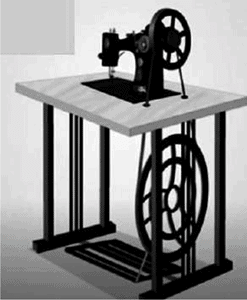
We see even we stop supply of driving force to the bigger wheel it still continues to run for a short time because of its moment of inertia. So, flywheel acts as an energy reservoir by storing and supplying mechanical energy when required. The kinetic energy stored in a flywheel is
![]()
(where I = moment of inertia and ω = angular velocity).
We see even we stop supply of driving force to the bigger wheel of foot operated sewing machine, it still continues to run for a short time. If the rim of this wheel is made thicker then
Flywheel and sewing machine
There is a difference between inertia and moment of inertia of a body. Inertia depends on the mass of the body but the moment of inertia about an axis depends on the mass of the body and the distribution of its mass about the axis. In the following figure, the masses of the two wheels are exactly equal but in the wheel (A) the mass is uniformly distributed and in the wheel (B) most of the mass is situated at the rim. Both the wheels rotate about axis passing through the centre. It is noticed that while the two wheel are set in rotation and left, wheel (B) continues rotating for a longer time.
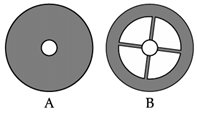
This means that the moment of inertia of wheel (B) is greater than the wheel (B). Also greater is the part of the mass of the body away from the axis of rotation, greater the moment of inertia of the body about the axis. Such a wheel is known as flywheel. Consider a foot operated sewing machine. It has of two wheels – one big and the other small. The wheels are connected by a rope. The bigger wheel acts as flywheel. The rope transfers the motion from this flywheel to the smaller wheel. Smaller wheel works as a pulley and also as a small flywheel.
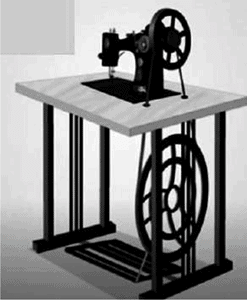
We see even we stop supply of driving force to the bigger wheel it still continues to run for a short time because of its moment of inertia. So, flywheel acts as an energy reservoir by storing and supplying mechanical energy when required. The kinetic energy stored in a flywheel is

(where I = moment of inertia and ω = angular velocity).
Energy stored in a flywheel is
Flywheel and sewing machine
There is a difference between inertia and moment of inertia of a body. Inertia depends on the mass of the body but the moment of inertia about an axis depends on the mass of the body and the distribution of its mass about the axis. In the following figure, the masses of the two wheels are exactly equal but in the wheel (A) the mass is uniformly distributed and in the wheel (B) most of the mass is situated at the rim. Both the wheels rotate about axis passing through the centre. It is noticed that while the two wheel are set in rotation and left, wheel (B) continues rotating for a longer time.
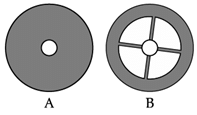
This means that the moment of inertia of wheel (B) is greater than the wheel (B). Also greater is the part of the mass of the body away from the axis of rotation, greater the moment of inertia of the body about the axis. Such a wheel is known as flywheel. Consider a foot operated sewing machine. It has of two wheels – one big and the other small. The wheels are connected by a rope. The bigger wheel acts as flywheel. The rope transfers the motion from this flywheel to the smaller wheel. Smaller wheel works as a pulley and also as a small flywheel.
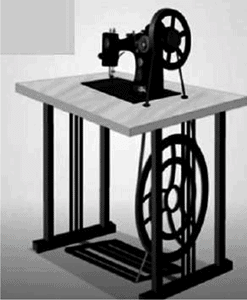
We see even we stop supply of driving force to the bigger wheel it still continues to run for a short time because of its moment of inertia. So, flywheel acts as an energy reservoir by storing and supplying mechanical energy when required. The kinetic energy stored in a flywheel is
![]()
(where I = moment of inertia and ω = angular velocity).
Which one of the following wheel (having same mass) will have highest moment of inertia about axis passing through the centre?

|
9 docs|1259 tests
|




















